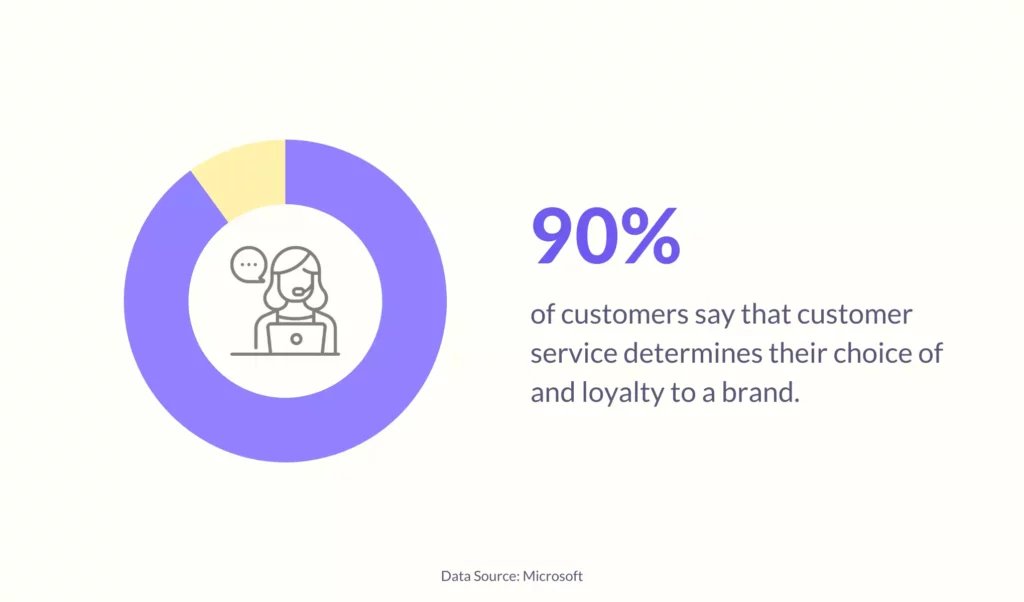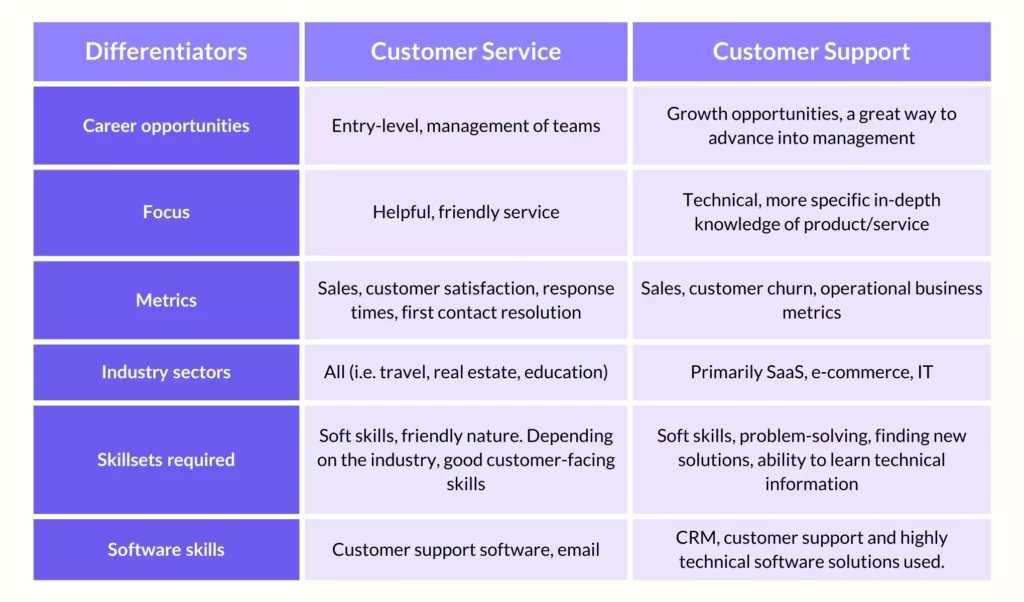Customer-facing teams have never been more critical.
Essential to the growth and development of any company in the modern-day business age, customer service and customer support play a pivotal role in providing a great customer experience.
Customer service fosters customer loyalty, word-of-mouth referrals, and recurring revenue when done well.
Data suggests that 90% of customers pick their brand based on customer service.

For some stand-out companies like Rackspace and Amex, customer service becomes a product of its own, drawing in new customers who want to support the company simply because of how they treat their clientele.
An increasing number of entrepreneurs recognize customer satisfaction and success as a road that ultimately leads to business success.
Though customer service and customer support are on the same spectrum and often used interchangeably, the two terms are quite different when anticipating customers’ needs.
Let us explain the differences while showing you how they can create a seamless customer experience and build positive customer relationships – to grow by leaps and bounds and reach highly sought-after success.
Table of Contents
- What is customer service?
- What is customer support?
- Customer service vs customer support: How do they compare?
- How customer service has evolved over the years
- How customer service supports the entire customer journey
- Customer support requires internal knowledge and product expertise
- Measuring customer service and customer support
- The shift towards customer success (and business success)
- Conclusion
What is customer service?
Customer service is about supporting a customer’s more generalized, non-technical concerns, ranging from finding a product, billing, upgrading, or even a refund. Ultimately, the focus of a company’s customer service department is to assist customers through their buying lifecycle, ensure customer care and satisfaction are at the forefront.
That might sound like customer support, but it’s not.
Here’s why.
What is customer support?
Customer support is a more narrowly defined aspect of the customer experience and handling technical problems. Customer support agents typically have deeper technical know-how.
However, customer support can even be automated by bots attempting to help customers in today’s modern age. Whether you use people or bots, the goal of customer support is to offer technical support to help solve customers’ issues.
Recommended Reading

Customer service vs customer support: How do they compare?
Customer support and customer service have similar goals, and that’s where much of the confusion lies. However, the main difference between customer support and customer service is that customer support is reactive, while customer service is proactive.
Because of this, the type of person required to work in customer service and customer support also differs.
As you can read from the table below, customer service agents will require different soft skills and use essential software to complete their roles. Customer support reps will need more problem-solving skills combined with knowledge of more technical software solutions.
A breakdown of customer service vs customer support
Let’s take a look at several differences between customer service and customer support.

How customer service has evolved over the years
Customer-focused businesses thrive on building strong customer relationships. They must develop a customer-centric culture from all business departments.
When companies created call centers in the 1960s, modern-day customer service flourished. Companies could take more calls while offering higher quality customer service.
Fast forward to the digital age, both customer service agents and businesses could service customers online, not only from call centers. Social media created yet another avenue for customers to tweet or post their concerns to firms.
Every customer-facing industry that serves customers will need customer support at some point in its business lifecycle.
With the demand for better customer service, businesses began using cloud-based software to efficiently manage all customer service channels.
Customer service software allows businesses to create automated processes that help them serve their customers better, providing fast and high-quality service and having access to their entire communication history – all in one place.
The adoption of customer service software began to pay dividends in customer service.
For example, 89 to 93% of customers are likely to make repeat purchases with companies that offer good customer service. While 70% of customers that cut ties with a company did so because they felt the business didn’t care about them.
Recommended Reading

Today, customer service has become intrinsically linked to business success.
How customer service supports the entire customer journey
The role of your customer service team is to guide customers at every stage of the customer lifecycle – from first-time contact to repeat purchases.
Having soft skills and an analytical understanding is essential for delivering excellent customer service. The top customer service representatives are clear, patient, empathetic, supportive, and pay close attention to the customer’s unique situation.
Customer service can include:
- making product or service recommendations
- onboarding new customers
- drawing up SLA contracts
- replying to comments on forums and social media
- handling customer interactions related to billing, shipping, etc.
- resolving non-technical account issues
- collecting customer reviews and feedback
- writing and deploying customer satisfaction surveys
- Upselling or offering discounts (when appropriate)
Great customer service is merely being the best at the above to beat the competition and drive better business growth.
Customer support requires internal knowledge and product expertise
Customer support refers to the range of services you offer your customers to solve technical issues that may arise when using your product or service.
It can be viewed (not always) as being more reactive, while customer service is more proactive.
Customer support professionals have customer service skills, notably empathy, leadership, and the ability to use positive language, but that’s only one part of their job.
They must also have technical proficiency and product expertise.
Other than the solid technical skills of the product, customer support representatives also need to possess collaboration skills because they often interact with product development and engineering teams for the best outcomes and solutions.
Everyday customer support activities include:
- real-time troubleshooting with customers on support emails, live chat, or screen sharing and remote screen control to offer a hands-on approach
- installing, maintaining, upgrading, and disposing of the product or service
- resetting passwords or recovering account data
- creating product documentation and customer support resources
- categorizing customer support conversations to highlight common issues
- responding to security breaches/suspicious activity
Measuring customer service and customer support
Customer service is typically measured by customer satisfaction (CSAT) scores where customers are surveyed on businesses services and products.
For instance, questions like ‘How would you rate your overall satisfaction with the product you recently purchased?’ or ‘how helpful was the customer service rep?’ are typically asked.
Customers are then given a scale to record their answers (usually between 1 and 5).
Recommended Reading

When a customer reaches out with a query, they want a quick response, so measuring first response time and first contact resolution is how you measure customer support success.
While sending an automated email to acknowledge their concerns have been logged is a best practice, what really matters to customers is whether their issue is dealt with quickly. So survey questions here would include ‘did you manage to get your issue resolved when calling the customer support team?’ or ‘how knowledgeable was the customer support rep?’
Ultimately, customer churn (where a customer decides to stop using your products or services) is a crucial customer service/support/success metric.
Other customer service reports include KPIs like incoming requests, handle time and tickets solved.
The shift towards customer success (and business success)
Customer service and customer support are often seen as ‘reactive’ tactics for maintaining customer retention rates and ensuring customer satisfaction isn’t compromised when there is an issue.
However, to create lasting positive customer experiences, companies need to focus on preparing and anticipating rather than repairing and fixing.
This is where customer success comes into play.
Customer success, a role commonly seen in SaaS companies, is focused on anticipating customers’ needs. To do this, customer success teams fully equipped with the latest customer success software will ideally aid in preventing potential customer problems.
For instance, research has shown that customers with a problem don’t always contact customer support. If these customers are dissatisfied, they will cease to be customers – 91% of those who don’t complain eventually churn.
Customer success was born out of an effort by businesses to help their customers be more successful, both with their services and products and in their business operations.
However, it is no longer sufficient to assume that a business will take on customer success management; for their customers to shine. They will need a customer success team that is proactive and data-led, supporting customers more effectively using a business’ services and products.
Hence, customer support software with analytics and a complete software tool stack is needed.
By being proactive and removing potential customer concerns, a strong customer success team allows businesses to retain those customers who don’t complain and remain customers.
When done effectively, customer success can reduce churn, improve retention and renewals, and drive revenue. For today’s businesses, those are all vital goals.
Conclusion
While there are several differences in approach, skills, and strategies, the end goal of customer-focused disciplines is all about improving the overall customer experience and delivering exceptional outcomes while increasing business growth.
Today’s top businesses prioritize helping their customers succeed.
With the rise of a broader consensus on adopting initiatives to put customers first, every business, no matter how big or small, can benefit from implementing a customer-first strategy to aid customers to succeed.
Help your customers, grow your business. Whether that’s through customer support, customer service or customer success. You decide.
Looking to level up your customer-first strategy?
Schedule a demo with Hiver – the world’s first helpdesk designed exclusively for Google Workspace – and see how effectively you can streamline your customer-facing emails and chats directly from Gmail.
Resources you’ll love:
- Lincoln Murphy’s Definitive Guide to Customer Success
- Totango’s guide on how customer success differs to CX
- The Ultimate Guide to Customer Follow Up (with Templates)
- 6 Customer Service Reports That You Need to Track
- 7 Best Customer Service Software for Small Businesses
- Biggest Benefits of Customer Support Software


































